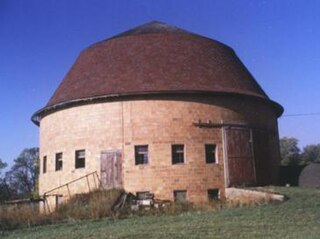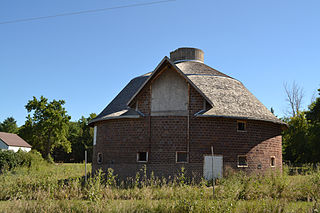
This is a list of the National Register of Historic Places listings in Benton County, Iowa.

The Nebergall "Knoll Crest" Round Barn is located between Davenport and Blue Grass in rural Scott County, Iowa, United States. It was built in 1914, and has been listed on the National Register of Historic Places since 1986.
The Round Barn, Bruce Township Section 3 is located in Bruce Township, Benton County, Iowa, United States. It was built in 1910 for use as a cattle barn. The building is a true round barn that measures 60 feet (18 m) in diameter. The barn is constructed of clay tile and features a conical roof. The structure does not have a cupola, but there is a silo that rises through the center. There is also a round machine shed on the same property. It has been listed on the National Register of Historic Places since 1986.
The Round Barn, Bruce Township Section 6 was located in Bruce Township, Benton County, Iowa, United States. It was built in 1914 as a general purpose barn. The building was a true round barn that measured 60 feet (18 m) in diameter. The barn was constructed of clay tile from the Johnston Brothers' Clay Works and it featured a conical roof. The structure did not have a cupola, but there was a silo that rose from the center. It was listed on the National Register of Historic Places (NRHP) in 1986.

The Round Barn, Washington Township is a historic building located south of Janesville, Iowa in Black Hawk County, United States. It was built in 1917 as a dairy barn. The building is a true round barn that measures 60 feet (18 m) in diameter. The structure is constructed in clay tile and features an aerator and a two-pitch roof. It was built around a silo with a water tank on top of it. While that is typical of this type of structure, it is the only one known to exist in Iowa. It has been listed on the National Register of Historic Places since 1986.

The Erza McKenzie Round Barn is a historic building located near Hazleton in rural Buchanan County, Iowa, United States. It was built in 1922 by Erza McKenzie for a dairy barn. The building is a true round barn that measures 70 feet (21 m) in diameter. The barn is constructed of clay tile and features small cupolas on the west, southwest and south sides of the structure. The building features a two-pitch roof and a central silo. It has been listed on the National Register of Historic Places since 1986.

The Robert Kirkpatrick Round Barn is a historic building located near Coggon in rural Delaware County, Iowa, United States. It was built in 1919 by Robert Kirkpatrick on his own farm. The building is a true round barn that measures 60 feet (18 m) in diameter. The barn is constructed of clay tiles and features a two-pitch roof with a large hay dormer on the east side and two smaller dormers on the west and north. It is one of 16 clay tile barns that were based on a design from the Johnson Brothers Clay Works in Fort Dodge, Iowa. The use of hollow clay tile is a distinctive trait in the construction of Iowa's round barns. For many years it was used as a dairy barn before becoming a horse barn. It has been listed on the National Register of Historic Places since 2005.

The Brooks Round Barn was a historical building located near Nashua in rural Floyd County, Iowa, United States. It was built in 1914 by Emil Cable, with Dale Butler as the supervisor. The building was a true round barn that measured 74 feet (22.6 m) in diameter. It was constructed of clay tile and featured a two-pitch roof and a 16-foot (4.9 m) central clay tile silo. The interior featured stanchions around the silo on the ground floor, double horse stalls and grain bins in a circular arrangement on the main floor, and a hayloft. The barn was listed on the National Register of Historic Places in 1986. It was destroyed in 1995.
The Spotts Round Barn is a historic building located near Charles City in rural Floyd County, Iowa, United States. It was built in 1914 as a dairy and horse barn. Its design was influenced by the Iowa Agricultural Experiment Station. The building is a true round barn that measures 55 feet (17 m) in diameter. It is constructed of clay tile from the Johnston Brothers Clay Works. It features a two-pitch roof, a large hay dormer on the north side and a 12-foot (3.7 m) central silo. The barn has been listed on the National Register of Historic Places since 1986.
The Round Barn, Norway Township is a historical building located in rural Norway Township, Winnebago County, Iowa, United States. It was built in 1920 as a dairy and horse barn. The building is a true round barn that measures 53 feet (16 m) in diameter. It is constructed of clay tile from the Johnston Brothers' Clay Works in Webster County. It features an aerator, conical roof and a hay dormer on the south side. The barn has been listed on the National Register of Historic Places since 1987.
The George Darrow Round Barn is a historic building located near Alta Vista in rural Chickasaw County, Iowa, United States. The true round barn was constructed of clay tile in 1916. The use of clay tiles suggests that it was influenced by the work of the Iowa Agricultural Experiment Station in the early 20th century. It has a diameter 64 feet (20 m), and a height of 50 feet (15 m). The barn features a two-pitch roof and a 14-foot (4.3 m) central clay tile silo. It was built as a dairy barn and it was used as such until 1978. Dairy cow stanchions surround the central silo on one side of the barn in a circular arrangement, and horse stalls surround the other side. The barn has been listed on the National Register of Historic Places (NRHP) since 1986. It has subsequently been torn down. It was removed from the NRHP in 2022.

The Herman Wood Round Barn is a historic building located near Iowa Falls in rural Franklin County, Iowa, United States. It was built in 1916 by Herman Wood as a cattle barn. Matt King of the Permanent Buildings Society of Des Moines acted as the building consultant. The building is a true round barn that measures 122 feet (37 m) in diameter. The barn is constructed of clay tile and features a 20-foot (6.1 m) silo that extends through the flat roof. The rather large structure is one of the more unusual round barns in Iowa. The rolled-asphalt roof is suspended by wire cables that are hooked to rods at the top of the silo. King designed the system and wrote an article concerning the barn's construction in a 1917 issue of American Carpenter and Builder. The barn has been listed on the National Register of Historic Places since 1986.

The Holtkamp Round Barn is a historic building located near Salem in rural Henry County, Iowa, United States. It was built in 1918 by its first owner B.J. Holtkamp who used the plans drawn up by Matt L. King. The building is a true round barn that measures 50 feet (15 m) in diameter. It is constructed of clay tile from Mt. Pleasant Brick & Tile Mfg. Co. of Mt. Pleasant, Iowa and features an aerator, hay carrier, and a two-pitch roof. It has been listed on the National Register of Historic Places since 1986.
The Eckle Round Barn is a historic building that was located near Shelby in rural Pottawattamie County, Iowa, United States. The true round barn was built by Ed Brown and George Robinson in 1928 for Richard Eckle. It has a diameter of 54 feet (16 m). The barn featured white horizontal siding, a two-pitch sectional roof, aerator and a central clay tile silo with a 14-foot (4.3 m) diameter. The barn was listed on the National Register of Historic Places in 1986. It has subsequently been torn down.

The Round Barn, Buckingham Township is an historic building located north of Traer in Tama County, Iowa, United States. It was built in 1920 as a general purpose barn. The building is a true round barn that measures 50 feet (15 m) in diameter. The structure is constructed in clay tile from the Johnston Brothers' Clay Works and features an aerator and a segmented two-pitch roof. It has been listed on the National Register of Historic Places since 1986.
The John W. Young Round Barn is an historic building located near Traer in rural Tama County, Iowa, United States. It was built in 1917 by Joe Seda as a general purpose barn. The building is a true round barn that measures 65 feet (20 m) in diameter. The structure is constructed in clay tile and features a two-pitch roof and an 18-foot (5.5 m) central silo that is 45 feet (14 m) high. It has been listed on the National Register of Historic Places since 1986.

The Wickfield Round Barn is a historic sale barn building located near Cantril in rural Van Buren County, Iowa, United States. Originally called Silvers Sale Pavilion, it was built in 1919 by Alva Hunt for $20,000. The true round barn measures 50 feet (15 m) in diameter. Frank Silvers, a successful hog breeder and businessman, operated the largest Hampshire hog farm in the world. The first floor had seating for 700 people. Silvers' business offices were also located on the first floor. The structure is constructed of clay tile and features an aerator. The two-pitch roof features eight dormers on the lower part and four dormers on the upper part of the roof. It has been listed on the National Register of Historic Places since 1986. There are no round barns in Iowa used as sale barns any longer, and this one is used for storage.

The Slayton Farms-Round Barn is a historic building located near Iowa Falls in rural Hardin County, Iowa, United States. Frank Slayton had it built in 1915 for use as a dairy barn. The barn is one of 16 that was built by the Johnston Brothers Clay Works from Fort Dodge, Iowa. It is constructed of hollow clay tiles and features a gambrel roof with two different pitches and hay dormer. Two aerators flank the central silo on the roof. The interior of the barn is fashioned around the silo from which silage was shoveled to feed the cattle. An overhead track system and a bucket for hauling materials remains intact. It has been listed on the National Register of Historic Places since 1999. Purchased by Engel Family in 2023.
The Octagon Round Barn, Indian Creek Township is a historic building located near Iowa Center in rural Story County, Iowa, United States. It was built in around 1880 as a dairy barn. The octagon-shaped building measures 50 feet (15 m) in diameter. The modified hip roof, heavy timber framing, rectangular interior plan, and general purpose use marks this as a design influenced by Lorenzo S. Coffin, who built the first round barn in Iowa. It has been listed on the National Register of Historic Places since 1986. The barn has deteriorated significantly and it is essentially a pile of wood now.
John McGreer Barn and Crib are a historic building (barn) and structure located in rural Harrison Township, Lee County, Iowa, United States. They are located on a farm northwest of the town of Donnellson. The agricultural buildings were listed on the National Register of Historic Places in 2001.












